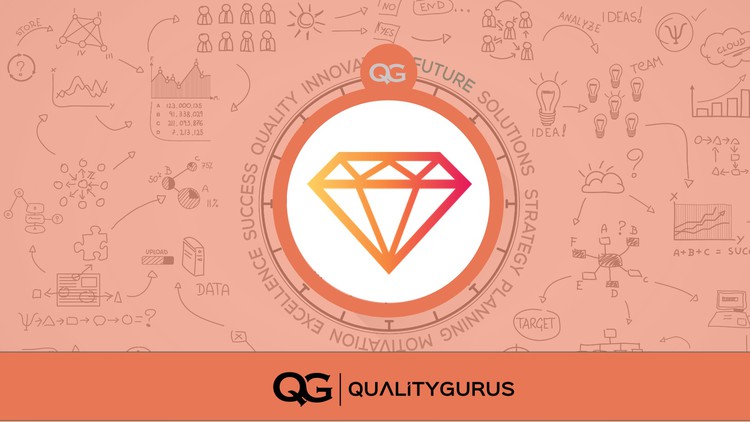
Lead Quality Management in the Organization • Transform the Organization to Become the Best-in-Class
☑ This course provides the basic Quality Management knowledge, that each employee in the organization should have.
☑ Understand what makes some organizations best-in-class organization.
☑ How to take the quality of your product or service to the next level?
- Are you new to Quality and want to start with a strong foundation of Quality Management concepts?
- Are you appearing in any certification exam such as PMP, CQA, CQE and want to refresh your basic understanding of Quality Management?
- Are you working in the field of Quality Management and want to refresh your knowledge?
Here is what everyone in the organization should know:
- Definitions of Quality
- How can you achieve quality if you don’t understand what quality is?
- Why do businesses need to produce quality products?
- Understand Garvin’s eight dimensions of quality: Performance, features, reliability, conformance, durability, serviceability, aesthetics, and perceived quality.
- Difference between Quality and Grade
- Difference between Quality Assurance and Quality Control
- Quality Management System
- History of Quality
- Quality Tools
- Learn about seven basic quality tools.
- Quality Costs – or the Cost of Poor Quality (COPQ)
- Visible and invisible costs of quality
- Prevention cost, appraisal cost, internal failure costs and external failure costs
- Why do we need to measure the cost of quality?
- Quality Awards – Deming Award, EFQM and MBNQA
- In this section, you will learn about these three top global quality awards.
- Quality Gurus – Edwards Deming, Joseph Juran and Philip Crosby.
- In this section learn about the life and teachings of these quality gurus.
- Understanding waste
- Three broad categories of waste: Muda, Mura and Muri
- TIMWOODS
- Transportation
- Inventory
- Motion
- Waiting
- Overprocessing / Extra Processing
- Overproduction
- Defects
- Skills Underutilized / Non-Utilized Talent
OVER 14,000 HIGHLY SATISFIED STUDENTS HAVE ALREADY TAKEN THIS COURSE.
English
Language
Quality Management Basics
What is Quality?
Download Slides
**** How to Define Quality? Seven Definitions of Quality. *****
Definition 1: Quality is Conformance to Requirements
Definition 2: Quality is Fitness for Use
Definition 3: Quality is Meeting Requirements
Definition 4: Quality is Exceeding Expectations
Definition 5: Quality means being Better than Competitors
Definition 6: Quality means being Defect Free
Definition 7: Quality as Defined by ISO 9000:2015
Difference between Quality and Grade
Why Quality?
Garvin’s Eight Dimensions of Quality
**** Garvin’s Eight Dimensions of Quality ****
1. Performance (Garvin’s Eight Dimensions of Quality)
2. Features (Garvin’s Eight Dimensions of Quality)
3. Reliability (Garvin’s Eight Dimensions of Quality)
4. Conformance (Garvin’s Eight Dimensions of Quality)
5. Durability (Garvin’s Eight Dimensions of Quality)
6. Serviceability (Garvin’s Eight Dimensions of Quality)
7. Aesthetics (Garvin’s Eight Dimensions of Quality)
8. Perceived Quality (Garvin’s Eight Dimensions of Quality)
Quality Assurance, Control and Management System
QA, QC and QMS – Introduction
Quality Control – Definition
Quality Assurance – Definition
Quality Control vs Quality Assurance
Quality Management System
Practice Activity – Quiz – Quality Management Basics
Quality Timeline
Brief History of Quality
Learning Quality from Top Three Quality Gurus
Quality Gurus – Introduction
*** Edwards Deming ***
Deming is best known for
Deming’s 14 Principles of Management
Principle # 1: Create Constancy of Purpose
Principle # 2: Adopt the New Philosophy
Principle # 3: Cease Dependence on Mass Inspection
Principle # 4: Don’t Award Business on the Basis of Price
Principle # 5: Improve Constantly and Forever
Principle # 6: Institute Training on the Job
Principle # 7: Institute Leadership
Principle # 8: Drive Out Fear
Principle # 9: Break Down Barriers
Principle # 10: Eliminate Numerical Goals, Posters and Slogan
Principle # 11: Eliminate Numeric Quotas
Principle # 12: Remove Barriers to Pride in Workmanship
Principle # 13: Education & Retraining
Principle # 14: Take Action
*** Joseph Juran ***
Juran is best known for
10 Steps to Achieve Quality by Juran
Juran’s Trilogy
*** Philip Crosby ***
Philip Crosby is best known for
Four Absolutes of Quality
Absolute #1: Quality is Conformance to Requirements
Absolute #2: The System of Quality is Prevention
Absolute #3: The Performance Standard is Zero Defects
Absolute #4: The Measurement of Quality is the Price of Non-conformance
Practice Activity – Quiz – Quality Gurus
Cost of Poor Quality
Cost of Quality – Introduction
Visible vs Invisible Cost of Poor Quality
Classification – Cost of Conformance and Non-conformance
Cost of Quality – 1. Prevention Cost
Cost of Quality – 2. Appraisal Cost
Cost of Quality – 3. Internal Failure Cost
Cost of Quality – 4. External Failure Cost
Why to Measure the Cost of Quality?
Understanding and Eliminating Wastes from Processes
Wastes – Introduction
Waste – Philosophy
Three Broad Categories of Wastes – 1. Muda
Three Broad Categories of Wastes – 2. Mura
Three Broad Categories of Wastes – 3. Muri
*** Seven Types of Muda – TIMWOOD ***
1. Transportation Waste
2. Inventory Waste
3. Motion Waste
4. Waiting Time Waste
5. Overprocessing Waste
6. Overproduction Waste
7. Defects Waste
8. Unexploited Knowledge (and the topic conclusion)
Seven Basic Quality Tools – All Quality Professionals Must Master
Seven Basic Quality Tools – Introduction
*** Seven Basic Quality Tools – List of Tools Covered ***
Tool #1: Check Sheet
Tool #1: Example of a Check Sheet
Tools #2: Cause and Effect Diagram
Tools #2: Example of a Cause and Effect Diagram
Tools #3: Histogram
Tools #3: Example of a Histogram
Tools #4: Pareto Chart
Tools #4: Example of a Pareto Chart
Tools #5: Scatter Diagram
Tools #5: Example of a Scatter Diagram
Tools #6: Control Chart
Tools #6: Example of a Control Chart
Tools #7: Stratification
Tools #7: Example of Stratification
Practice Activity – Quality Tools
Quality Awards
Quality Awards – Introduction
Three Quality/ Business Excellence Awards
MBNQ Award
Certificate of Completion
Download Slides
Course Level Quiz
How to Download Your Certificate of Completion